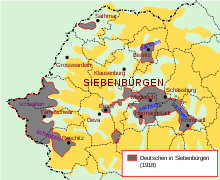Transylvanian Saxon dialect

The Transylvanian Saxon (Saxon: Siwweberjesch Såksesch or just Såksesch, Hungarian: Erdélyi szász nyelv, German: Siebenbürgersächsisch or Siebenbürgisch-Sächsische Sprache, Romanian: Limba săsească) is a dialect of the Transylvanian Saxons. It belongs to the Moselle Franconian group of West Central German dialects.
The language was mainly spoken in Transylvania, Romania (prior to 1918, Hungary) by persons of German origin who settled there in the 12th century. The majority of the speakers have emigrated in several waves to Germany, Austria, the USA, Canada and other Western countries, and preserved (at least temporarily) their specific language there. Before the revolution of 1989 in Romania, the majority of the Transylvanian Saxons were still living in Transylvania. During the communist dictatorship of Nicolae Ceaușescu, many thousands of Saxons were sold per capita for a huge amount of money paid to Romania by West Germany. By 1990, the number of Saxons living in Transylvania has decreased dramatically. After the fall of communism, during 1991—1994, the vast majority of those who remained in Transylvania emigrated to Germany, leaving just a minority of about 15 000 Transylvanian Saxon persons in Romania. The number of Transylvanian Saxon speakers today is estimated to be 200 000 persons. It is the native language of the current President of Romania Klaus Iohannis.
Bibliography
- Siebenbürgisch-Sächsisches Wörterbuch. A. Schullerus, B. Capesius, A. Tudt, S. Haldenwang et al. (in German)
- Band 1, Buchstabe A – C, 1925, de Gruyter, ASIN: B0000BUORT
- Band 2, Buchstabe D – F, 1926, de Gruyter, ASIN: B0000BUORU
- Band 3, Buchstabe G, 1971, de Gruyter, ASIN: B0000BUORV
- Band 4, Buchstabe H – J, 1972
- Band 5, Buchstabe K, 1975
- Band 6, Buchstabe L, 1997, Böhlau Verlag, ISBN 978-3-412-03286-9
- Band 7: Buchstabe M, 1998, Böhlau Verlag, ISBN 978-3-412-09098-2
- Band 8, Buchstabe N - P, 2002, Böhlau Verlag, ISBN 978-3-412-12801-2
- Band 9: Buchstabe Q - R, 2007, Böhlau Verlag, ISBN 978-3-412-06906-3
External links
- SibiWeb: Die Sprache des siebenbürgisch-sächsischen Volkes von Adolf Schullerus (German)
- Verband der Siebenbürgersachsen in Deutschland: Sprachaufnahmen in siebenbürgisch-sächsischer Mundart - Audiosamples (German, Såksesch)
- Siebenbürgersachsen Baden-Württemberg: Die Mundart der Siebenbürger Sachsen von Waltraut Schuller (German)
- Hörprobe in Siebenbürgersächsisch (Mundart von Honigberg - Hărman) und Vergleich mit anderen Germanischen Sprachen (German)